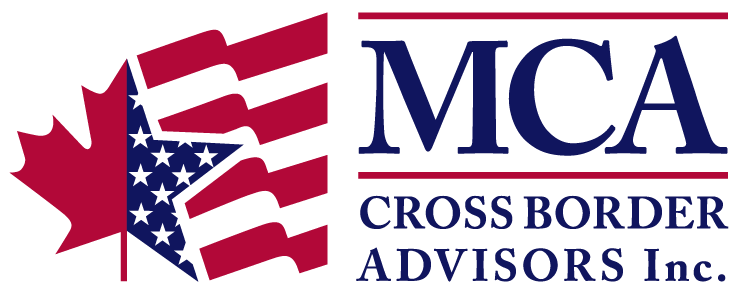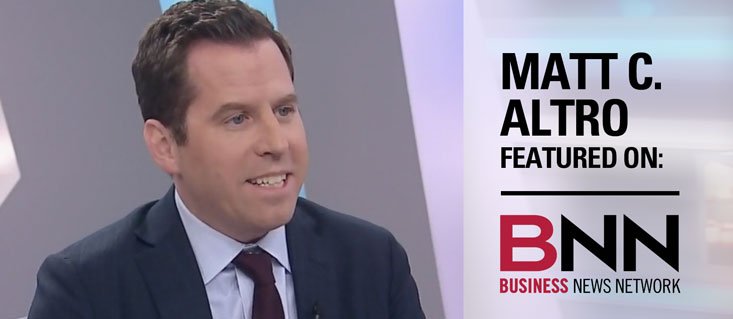Original Post: February 14, 2018
Updated Post: March 21, 2018
We are very pleased to share that our President and CEO was recently interviewed by BNN for their “Your Money Month” special segment. BNN looked to Matt Altro as a Cross Border Financial Planner for his top tax tips for Snowbirds, explaining which investments are subject to death tax (US estate tax), and a potential RRSP tax savings tip for Snowbirds who want to move to the US.
Below is a transcript of the interview which aired live on February 6, 2018 on BNN.
Host: February is Your Money Month here on BNN and every day we’re going to be bringing you experts on the show and how to get your personal finances in order. Today we’re looking at the top tax tips for Snowbirds. For that let’s now bring in Matt Altro, he’s the Principal and CEO of MCA Cross Border Advisors. Good to be with you Matt, thanks for coming in.
Matt: Great to be here.
Host: There’s a lot to cover, I first want to get your definition of a Snowbird. Is it a Canadian in the US or a Canadian with a US green card or citizenship as well?
Matt: Well my definition of a Snowbird is somebody who doesn’t like the cold, and a Canadian who wants to spend some time in the US, usually in the Sunbelt, so is it a month a year or six months a year? Usually the snowbird is usually more like 6 months a year. Trying to spend as much time as they can in the US, but they’re not a US tax person.
Host: Ok, so then let’s talk about how the tax changes in the US may affect them. Or even just prior to the tax changes, what they need to know as a Snowbird.
Matt: Sure. Well prior to the tax changes the Snowbird needs to know how many days they can spend in the US before the run into problems. And its kind of a confusing topic because there’s one amount of days for immigration which you shouldn’t spend more than approximately six months in a rolling year, and its a different amount of days for tax. There’s a test called the substantial presence test and you generally have to do a calculation which is quite complex to figure out how many days in the current year, plus a third of the days in the last year, and a sixth of the days two years ago and make sure that doesn’t equal 182, and then you won’t have a problem with US tax rules. So, generally all that to be said you shouldn’t spend more than 180 days in the US a year or you would have problems with either immigration or tax rules.
Host: So, it sounds like its a little bit different on the tax front. The immigration front sounds easy to calculate, but the tax less so because you actually have to think of an equation for this year, last year and what I’m going to do next year. So how is it still 180?
Matt: That’s a great point. So, the calculation is actually the substantial presence test and if you’re spending more than about 120 days every year, which most Snowbirds are because that’s only four months, you’re actually a US tax resident under domestic tax rules. However, all the Snowbirds are thinking well I’m spending six months and I’m not a US tax person. The reason is because there is a Closer Connection Exemption, a form that Snowbirds should fill out and it says that I know I’m meeting the SPT but I have a closer connection to Canada and therefore I’m no longer a US tax resident if I file this form due by June 15 of the following year to the IRS.
Host: Okay
Matt: So that’s how you get back to being at about 180 days per year in the US
Host: So, what’s the number on that form?
Matt: Form 8840
Host: 8840
Matt: That’s the one
Host: I knew there was a number! Ok so that’s really important. So, when you say though that they need to file it by the following year, does that mean that if I’m in Florida right now February is that 2018 or 2019?
Matt: That’s 2019. Filing in 2019.
Host: Gives people time to think about this.
Matt: So right now, they’re thinking about filing for 2017 in June of 2018.
Host: Got it. Ok. That’s important. The closer connection form that you send the IRS, 8840 is the number. So that’s important, that’s how much time you spend in the States. So what else do we need to know as Canadian Snowbirds?
Matt: Well, there’s really important changes with respect to the US estate tax. US estate tax, actually as a Canadian you could actually owe money to the IRS on death even if you’re not a US person. If you own US property / US real estate or US shares of stock in your name personally and your net worth is over, now the new rule is $11.2M it used to be $5.6M until January 1. If your net worth was below $5.6M then you didn’t have any tax, however if it was over you could have up to 40% tax on your US assets when you die as a Canadian. So now, Canadians are probably happy to hear that its doubled, and that the exemption is now $11.2M per person.
Host: And that was under the US tax reform.
Matt: Correct.
Host: Now, if somebody is over $11.2M who’s watching? Can they have different types of trusts that are formed to protect that; what kind of trusts? I know that’s not necessarily your area, or is it?
Matt: Yes, absolutely. A lot of people do just go down and do the simplest approach: put it in my name. Find something I love and put it in their name personally the title that is. But if they take some time and do their research and find that there’s actually structures like putting it in a structure like a Cross Border Irrevocable Trust, that actually could shield that asset by being taxed by the IRS when they pass away and its no longer part of their US taxable estate even if their net worth is over the $11.2M. And I should also add, that number $11.2M its not there forever. These new US tax rules are going to sunset at the end of 2025. So, if nothing happens its going to revert back down to $5.6M.
Host: But if you are above that $11.2M or you’re recognizing the sunset, a cross border irrevocable trust will protect this?
Matt: Yes, that’s right.
Host: Is that some treaty between the US and Canada? Why does that trust work?
Matt: Right, well there’s certain rules in the IRC (the Internal Revenue Code) that show if the asset is in an irrevocable trust and its drafted correctly, then it doesn’t form part of that person’s taxable estate when they pass away.
Host: Ok. I also want to ask you about Old Age Security. How could that affect Canadians?
Matt: Oh, great question. Old Age Security is a nice little amount of money that Canadians get, $6,500 per person per year at age 65 if you’ve been a Canadian resident most of your life. But most of your viewers as wealthy Canadians when they hit 65 actually don’t see a penny, because what they see is something called OAS clawback. And its exactly what it sounds like, the government comes in and says if your income every year is more than $70,000 you don’t get any of your OAS; it starts to be clawed back. Now, what’s interesting is most of these Snowbirds who are there counting their days and wanting to spend more time in the US – if they get a proper immigration plan and actually spend maybe 8 or 9 months in the US, actually take the plunge and become a US tax resident, exit Canada for tax purposes, Canada will no longer clawback the person’s OAS. So that’s another $13,000 a year for Canadians who actually become US residents.
Host: Ok so, they can collect their OAS if they spend even more time in the US, become a resident, but then of course you have the cost of healthcare.
Matt: You got it, yeah, and its going up by the day.
Host: In the United States.
Matt: Yes, so the healthcare is something you have to marry up but the OAS is not the only savings because there are some other substantial opportunities for savings as well to greatly offset the healthcare.
Host: Really?
Matt: Oh, yes.
Host: You really think so?
Matt: Oh yes, I mean for example Canadians who contribute to RRSP, its RRSP season right? So I love RRSPs, you make a contribution, you get a tax deduction, it grows tax deferred, but our wealthy Canadians are going to pay tax at the marginal rate, probably highest rate of 54% in retirement when they take it out. As a non-resident, Canada will allow individuals to take out their RRSPs at much lower rates.
Host: Wow, you’re kidding.
Matt: All the way down to 15% possibly.
Host: Wow.
Matt: So 54% to 15%, that’s almost a 40% savings. Imagine a million or two-million-dollar RRSP? You’re talking about a huge amount of saving.
Host: That’s incredible. So that savings will compensate to your point for your healthcare costs in the US?
Matt: Definitely, and more.
Host: And more. But you need to have a good plan though.
Matt: Absolutely. Don’t do this without planning it out, absolutely.
Host: Now we have to go, but that was great. Thank you very much.
Matt: Thank you it was great to be here.
[su_button size=”6″ url=”https://mcacrossborder.com//consultation/” background=”#10155e”]Request a Consultation[/su_button]
——–
MCA Cross Border Advisors, Inc. is a registered investment adviser. Information presented is for educational purposes only and does not intend to make an offer or solicitation for the sale or purchase of any specific securities, investments, or investment strategies. Investments involve risk and, unless otherwise stated, are not guaranteed. Be sure to first consult with a qualified financial adviser and/or tax professional before implementing any strategy discussed herein. Past performance is not indicative of future performance.

